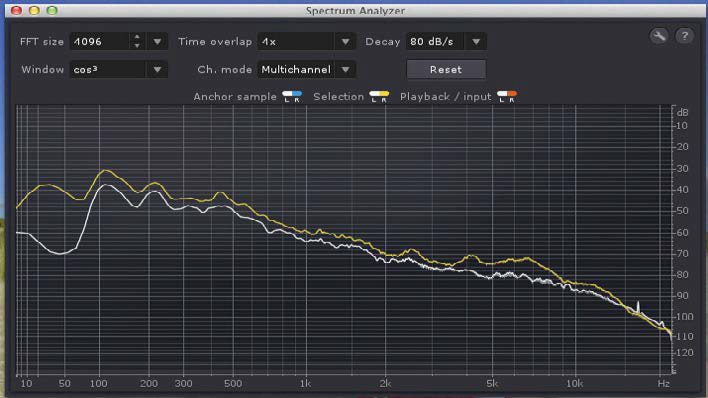DPA d:fine In-Ear Broadcast Headset Mic

The d:fine in-ear broadcast headset in use
DPA’s d:fine in-ear broadcast headset microphones are exceptionally small, lightweight, and barely visible, yet deliver the full audio frequency spectrum and sound fidelity of a full size condenser mic. The headsets come in several varieties, offering directional or omnidirectional microphones, and can be supplied with one or two in-ear transducers. These are ideal for on-air talent or performers who need recording-grade audio capture, but require mobility and a nearly invisible microphone. The headsets are designed to be connected to a wireless transmitter.
FEATURES
DPA d:fine in-ear headsets are designed to be as small and unobtrusive as possible, while employing an advanced microphone capsule that delivers the same frequency response found in a high-quality recording microphone, such as the electret condenser models commonly used in live event and studio recording. The obvious advantage with the DPA headset is that it’s worn by the talent, eliminating the need to hold a mic. And as the distance to the sound source remains constant, there’s no variation in audio levels and bass response.
For this review, I evaluated the DPA’s single ear model. The “single ear” designation refers to the transducer that is inserted in the user’s ear for talkback, monitoring directions, or hearing any desired signal feed. The d:fine headset is also available for double ear monitoring. One can select a configuration that has an ear mount on only one side to provide total invisibility. Other choices include directional or omnidirectional microphone capsules.
While DPA has invested a great deal of engineering finesse to create a minimally apparent headset apparatus, the most significant feature is the overall microphone performance. Both the directional and omnidirectional microphones yield an impressive frequency response ranging from 20 Hz to 20 kHz, and truly cover the entire audible frequency range.
The unit I reviewed employed the d:fine 66 omnidirectional microphone capsule which maintains a perfectly flat frequency response between 20 and 5 kHz and elevates output slightly between 5 kHz and 20 kHz in order to capture vocal sibilance. Another model, the d:fine 88 directional microphone, has an inherent proximity effect which enhances bass pickup as the microphone is placed closer to the sound source. Although the microphone capsule is smaller than an eraser on a mechanical pencil, it performs like a full-sized recording mic. Its signal-to-noise ratio is 68 dB, there’s less than one percent harmonic distortion and the unit sports a 97 dB dynamic range.
The DPA engineers didn’t scrimp on the in-ear monitor either. It provides clear, wide spectrum audio quality, and there is no leakage of sound to the microphone capsule.
The headset is almost weightless, and consists of a thin wire bracket that encircles the back of the neck on the dual-ear mount models. Flexible rubber coils curl around the ears, holding the headset in a very stable position. The microphone capsule is on the end of a durable, yet malleable boom, which can be adjusted to change the distance from the mouth to accentuate or attenuate bass response if needed. The cables from both the microphone and in-ear monitor are linked to avoid tangling. These mics can be fitted with appropriate connectors to fit any wireless transmitter on the market.

The spectrum analysis graph comparing audio performance of the d:fine mic with that of a high quality condenser microphone.
IN USE
In testing the DPA d:fine headset, I connected it to a Sennheiser EW100 G2 wire-less mic system using a supplied adapter. I then connected the receiver to an input box set up to work with Avid Pro Tools software.
As the headset is made of very light and thin materials, it takes a bit of adjusting to get it properly placed in position. However, once I mounted it correctly, I found it to be surprisingly stable. And within a few minutes, I forgot that I was wearing any apparatus at all. With the wireless transmitter, it provides complete freedom of movement.
My first test was to see how well the in-ear transducer worked. So, on the Pro Tools timeline, I recorded af vocal selection on track one. Then, using the in-ear monitor, I listened to that track while recording a new track on the second channel. This worked just as if I were doing a multitrack recording session. I could hear the audio on track 1 very clearly, and was able to sync a second track to it with ease. The thing that impressed me most in this test was the clarity of the audio coming through the earpiece. It was comparable to the sound of a high-quality headphone for music listening. This left me thinking that the DPA d:fine headset could also be used in multitrack music recording—in addition to the broadcast use it was primarily designed for—as it allows clear monitoring of pre-recorded tracks while laying down a new one.
Of course the ultimate test is the quality of the microphone. To establish this, I recorded a vocal track using the DPA d:fine headset, then I recorded a parallel vocal track using a high-quality condenser microphone that I use for music recording.
After recording both tracks, I listened to them carefully over a set of speakers—alternating between the tracks—and found the audio quality to be virtually identical.
However, just in case my ears were fooling me, I performed one more objective technical test. I imported the two-track audio file into iZotope’s RX3 audio analyzing software and pulled up the spectrum analyzer function to view a graphic image of the frequency response for each audio source. The graph showed two differently colored lines representing the frequency response of each track. When I analyzed the graph, the frequency curve for each track was virtually identical, indicating that both microphones were delivering identical frequency responses. I found this to be compelling evidence that the audio quality delivered by the DPA d:fine headset is equivalent to the audio delivered by a high quality, full-size condenser microphone.
SUMMARY
DPA’s d:fine in-ear broadcast headset microphone delivers outstanding audio quality in a wearable form that’s as close as possible to being invisible. While the microphone capsule is smaller than a thumbtack, it’s been so finely engineered that it produces audio equivalent to full-sized professional recording microphones. The in-ear monitor expands its capability to a host of possible applications, including any situation that involves on-air broadcast talent or live performance, as well as musical performances and even studio recording.
Geoff Poister, Ph.D., is a member of the film and television faculty at Boston University and a regular contributor toTV Technology.
FAST FACTS
APPLICATION
Audio pickup when a worn headset is desired
KEY FEATURES
High-quality audio pickup from a very small device
PRICE
Various models with prices starting at $770 MSRP
CONTACT
DPA Microphones 303-485-1025
Get the TV Tech Newsletter
The professional video industry's #1 source for news, trends and product and tech information. Sign up below.
